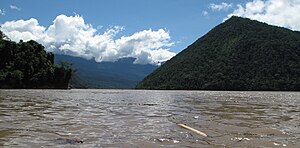| This article does not cite any sources. Please help improve this article by adding citations to reliable sources. Unsourced material may be challenged and removed. Find sources: "Tambo River" Peru – news · newspapers · books · scholar · JSTOR (December 2009) (Learn how and when to remove this message) |
| Tambo River | |
|---|---|
 View of the Tambo River near Puerto Prado View of the Tambo River near Puerto Prado | |
 Map of large rivers in south-central Peru Map of large rivers in south-central Peru | |
| Location | |
| Country | Peru |
| Physical characteristics | |
| Source | Confluence of Ene and Perené Rivers |
| • location | Peru |
| • coordinates | 11°9′56″S 74°14′7″W / 11.16556°S 74.23528°W / -11.16556; -74.23528 |
| • elevation | 400 m (1,300 ft) |
| Mouth | Ucayali River |
| • location | confluence with Urubamba River, Peru |
| • coordinates | 10°41′57″S 73°45′22″W / 10.69917°S 73.75611°W / -10.69917; -73.75611 |
| • elevation | 287 m (942 ft) |
| Length | 159 km (99 mi) |
| Discharge | |
| • average | 2,800 m/s (99,000 cu ft/s) |
The Tambo River (Spanish: Río Tambo) is a Peruvian river on the eastern slopes of the Andes. The name only refers to a relatively short section of the waterbody; about 159 km (99 mi) long. It starts at the confluence of the Ene and Perené Rivers at the town of Puerto Prado. From here the Tambo flows 70 km (43 mi) in an easterly direction and then turns north. When merging with the Urubamba River at the town of Atalaya, it becomes the Ucayali River.
The Tambo is part of the headwaters of the Amazon River whose origin is the Mantaro River at Cordilerra Ruminator Cruz.
This Ucayali Region geography article is a stub. You can help Misplaced Pages by expanding it. |
This article related to a river in Peru is a stub. You can help Misplaced Pages by expanding it. |